Table of Contents
Status page tools have become a crucial component of modern web service management, providing real-time updates to users during incidents, outages, or maintenance events. These tools offer a dedicated page that displays the status of a service or system, informing users about any disruptions or issues that may affect their experience. In this comprehensive guide, we will explore various status page tools available in the market, their features, best practices for setting up and managing a status page, and real-world examples to help you make an informed decision for your organization's needs.
Status Page Tools
Status page tools come in various forms, including software solutions, hosted services, and open-source options. Here are some of the top status page tools that are commonly used:
Statusway
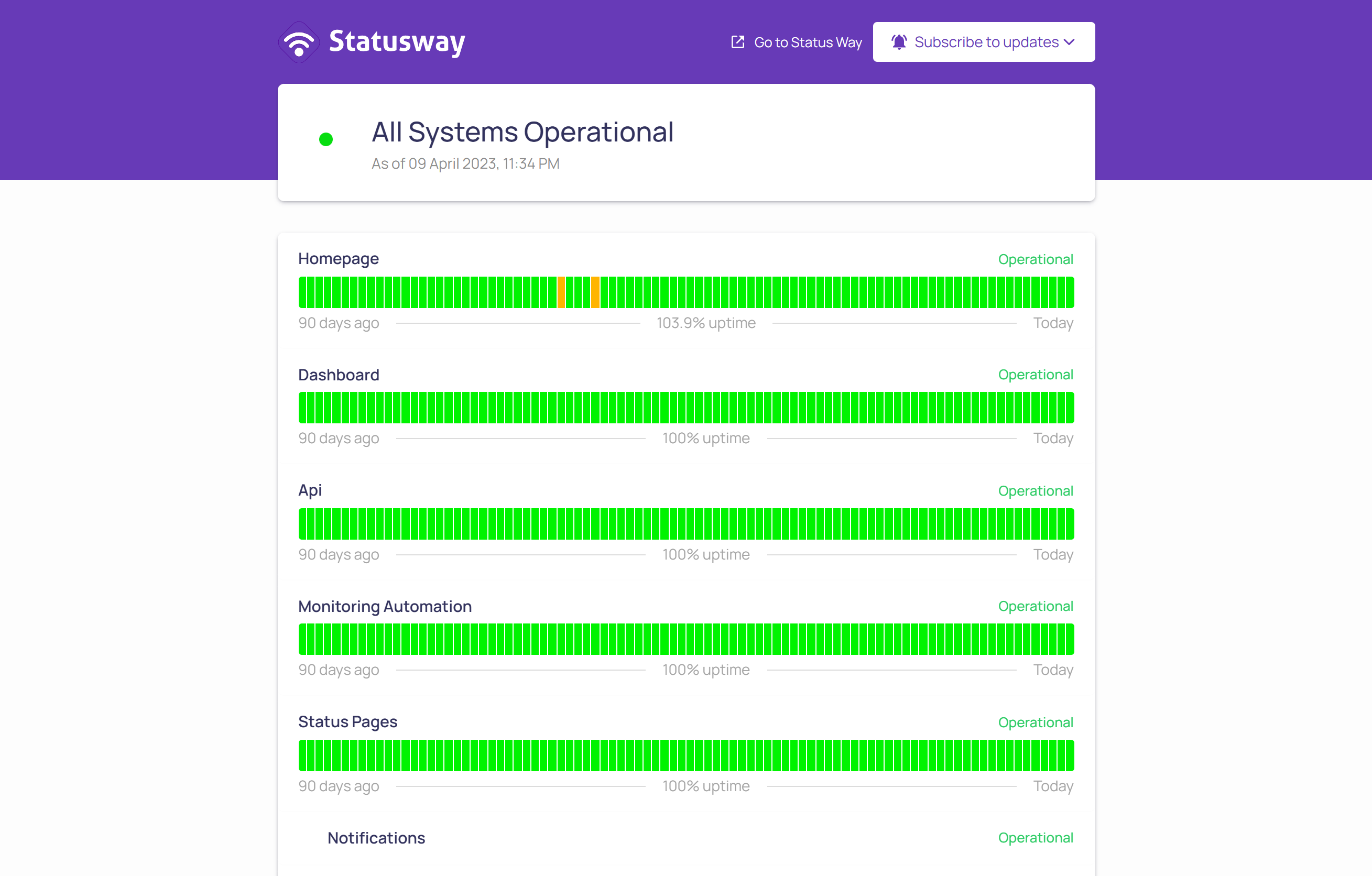
Statusway is a cloud-based platform that offers a powerful combination of a status page and incident management system tailored specifically for SaaS (Software as a Service) companies. Designed to keep SaaS companies and their customers informed about the status of their services, Statusway offers a range of features to streamline incident communication and ensure efficient incident resolution.
With Statusway, SaaS companies can create a customized status page that provides real-time updates on the uptime of their services, any incidents that may have occurred, and the current status of those incidents. The status page is fully customizable, allowing companies to brand it according to their own design preferences, and offers data visualization and reporting tools to help companies analyze their service uptime.
One of the key features of Statusway is its incident management capabilities. SaaS companies can easily track, manage, and communicate about incidents in real-time using the platform. This includes automated incident communication to keep customers informed about the status of incidents and the steps being taken to resolve them. Real-time notifications can be sent to customers, internal teams, and other stakeholders to ensure timely and efficient incident resolution.
In addition to incident management, Statusway offers integration with various monitoring and alerting tools, such as PagerDuty and Datadog. This allows SaaS companies to consolidate their incident management processes and centralize incident communication, reducing the need to switch between different tools and ensuring a streamlined and efficient workflow.
Pros:
- Seamless integration with Freshworks' suite of products.
- Free sign-up and various integrations with popular communication tools.
- Customization options for alert emails.
- Convenient for users who are already using Freshworks' products.
Check out the live demo.
Freshstatus
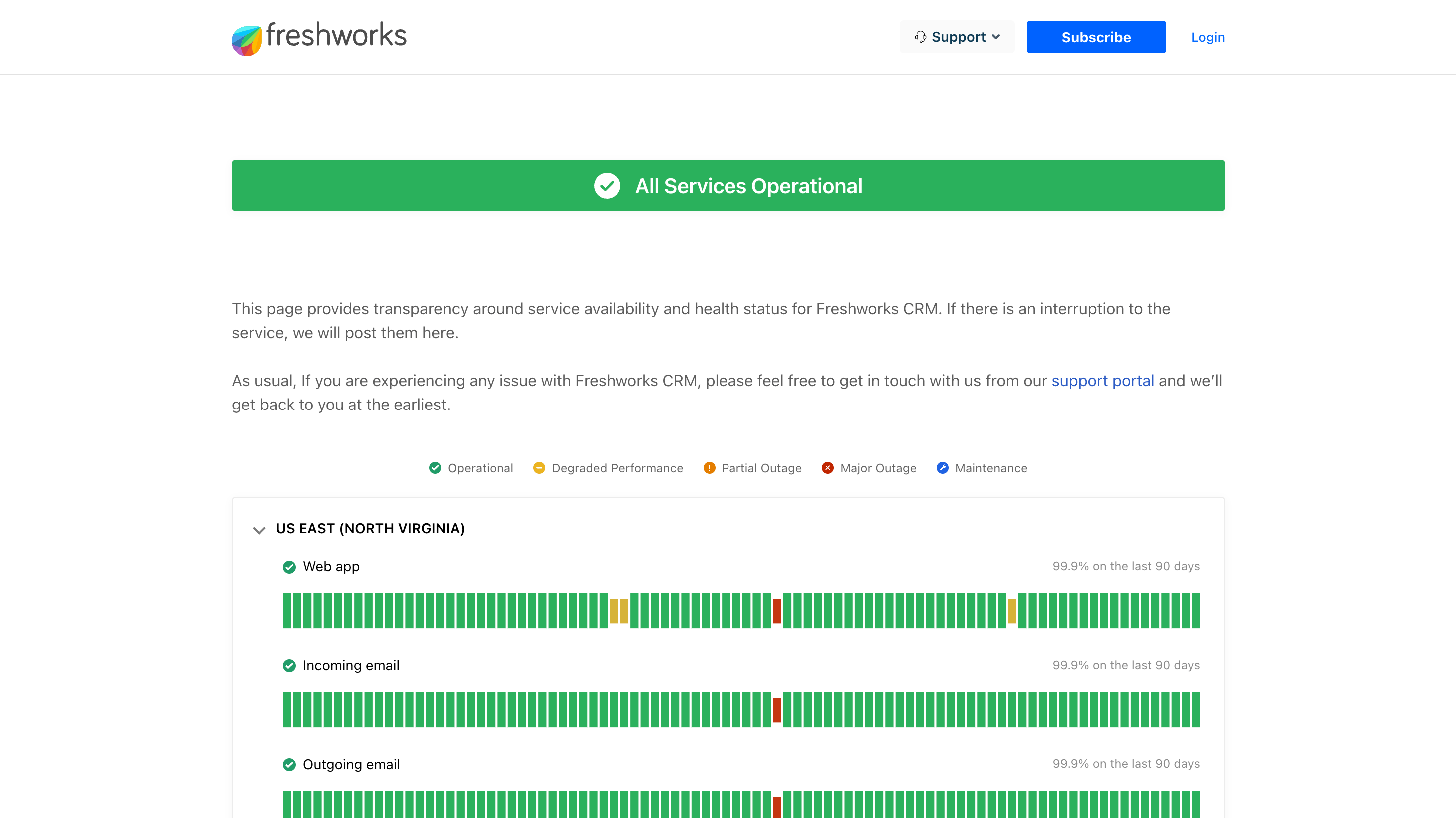
Freshstatus is a status page service that is integrated with Freshworks' suite of products. It offers free sign-up and comes with various integrations such as Twitter, Slack, Webhooks, and other Freshworks services like Freshping, Freshdesk, and Freshservice. This makes it a convenient choice for users who are already using Freshworks' products and want to have a status page within their existing platform. Freshstatus also supports customizing the alert emails, providing flexibility in communication with users during incidents.
Pros
- Seamless integration with Freshworks' suite of products.
- Free sign-up and various integrations with popular communication tools.
- Customization options for alert emails.
- Convenient for users who are already using Freshworks' products.
Cons
- Limited features compared to some other tools.
- May not be suitable for users who are not using Freshworks' products.
- May require additional integrations for advanced monitoring.
Cronitor Status Pages
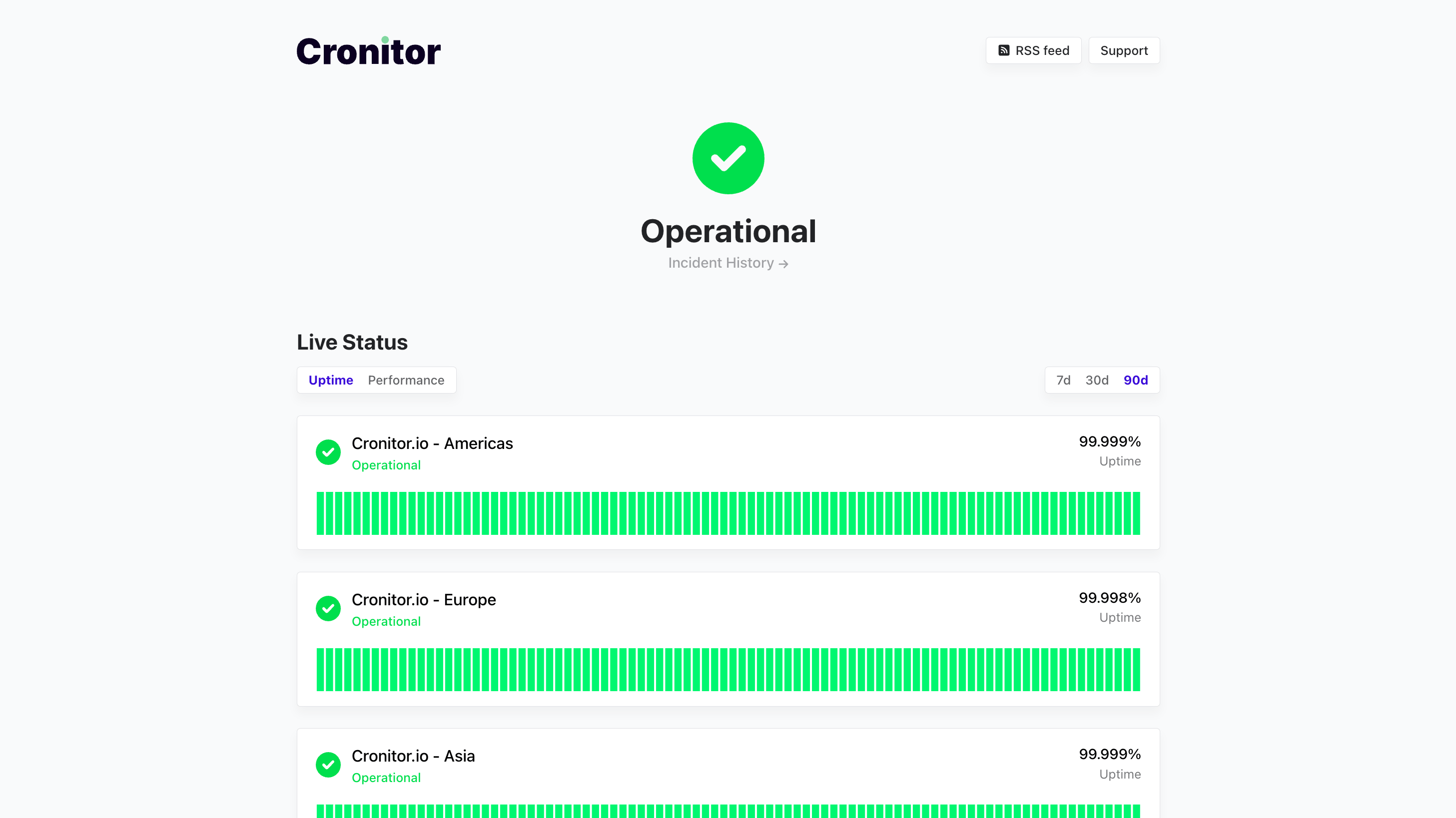
Cronitor is an all-in-one solution that allows you to create status pages with built-in monitoring. Its free tier offers generous features such as uptime monitoring, real user monitoring (RUM), and cron job monitoring. Cronitor also allows easy customization of status pages with your own domain, company logo, and support links. Automated incident management automates incident publishing and resolution without manual intervention. Private pages for internal teams can also be set up with IP ranges or password protection.
Pros
- Simple and fast solution for creating status pages with built-in monitoring.
- Generous features offered in the free tier.
- Easy customization options for status pages.
- Automated incident management for efficient incident communication.
- Private pages for internal teams.
Cons
- Limited customization options compared to some other tools.
- May not be suitable for complex monitoring requirements.
Odown
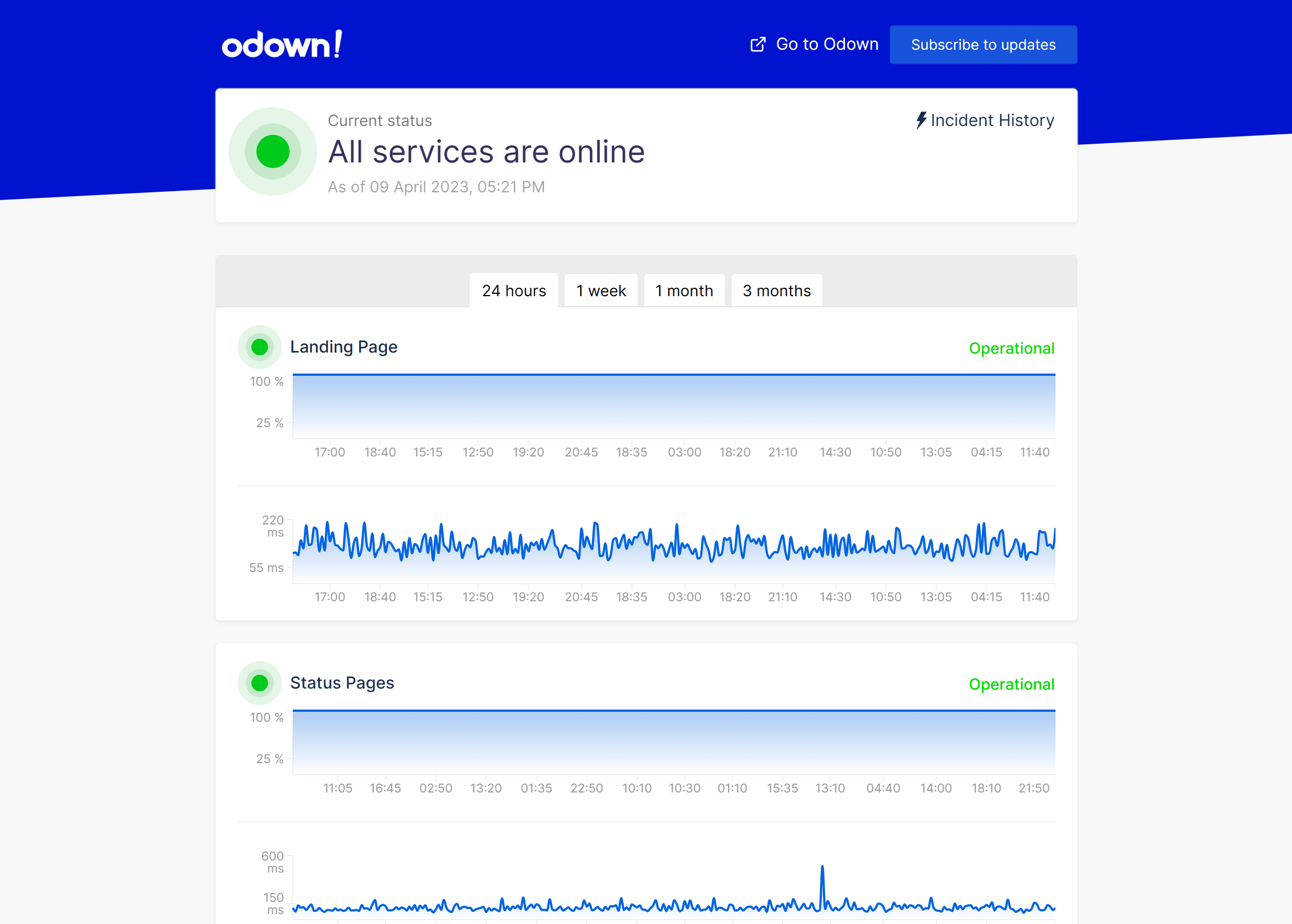
Odown is a user-friendly status page tool that offers simplicity and ease of use. It allows you to create and manage status pages with minimal effort, making it a great option for small to medium-sized businesses. Odown provides features such as incident tracking, custom incident templates, and automatic notifications to keep your users informed during incidents.
Pros
- Simple and user-friendly interface for easy status page creation and management.
- Incident tracking and custom incident templates for effective communication during incidents.
- Automatic notifications to keep users updated.
- Affordable pricing plans suitable for small to medium-sized businesses.
Cons
- May not have as extensive features as some other commercial tools.
- Limited integrations compared to more robust solutions.
- May not be suitable for larger enterprises with complex requirements.
Atlassian Statuspage
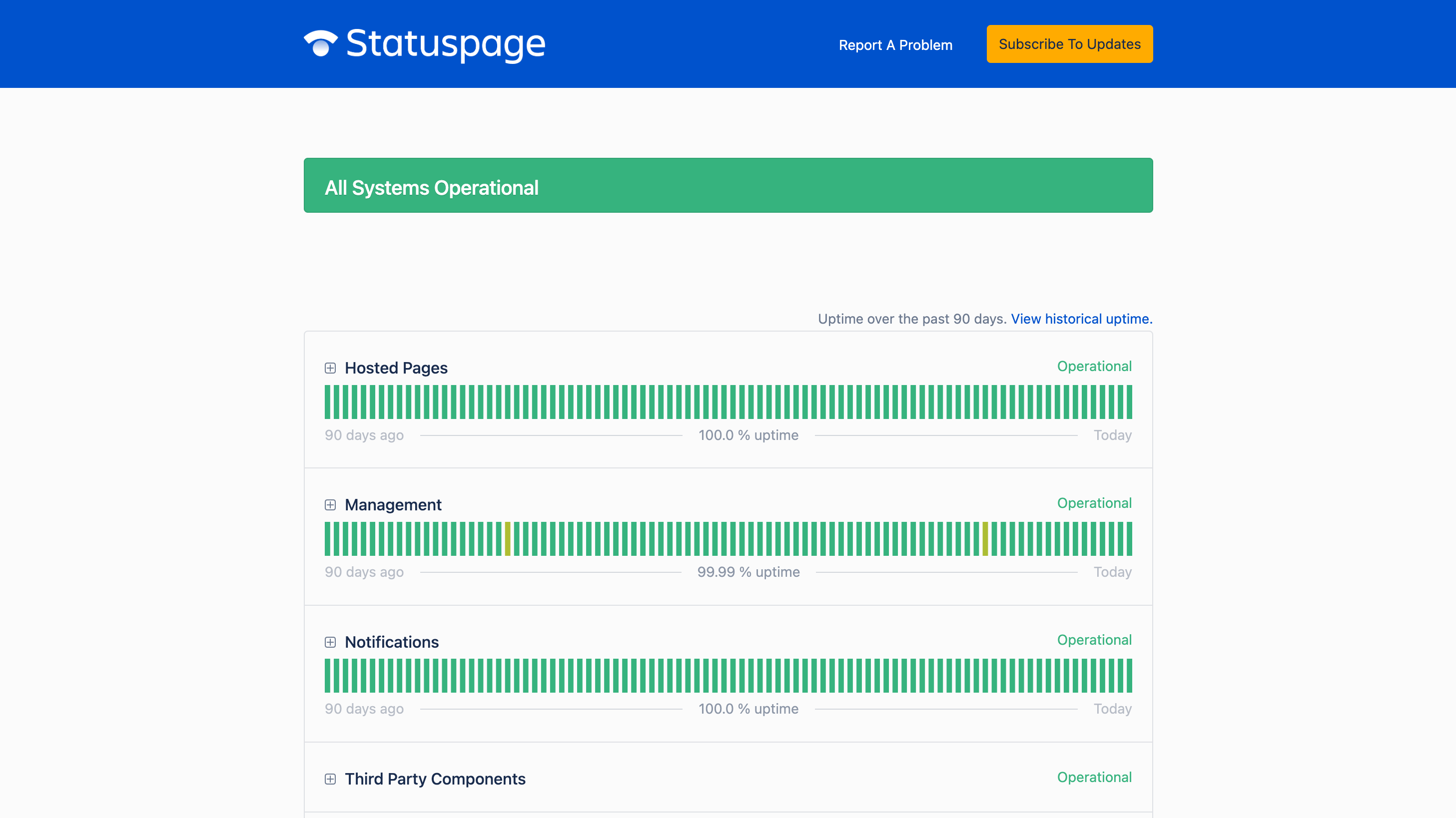
Atlassian Statuspage is a popular and feature-rich tool for creating status pages. Its free tier includes 100 subscribers, 2 team members, 2 metrics, and email or Slack notifications. Paid plans offer customization options such as custom CSS/HTML/JS for those who require specific features. Atlassian Statuspage is a suitable choice for users who are already using Atlassian's products and prefer to remain within their platform.
Pros
- Well-known and widely used tool with a rich set of features.
- Free tier with a decent amount of subscribers and team members.
- Customization options for advanced users.
- Integration with other Atlassian products for seamless workflow.
Cons
- May be expensive for small businesses or startups.
- Some advanced features may require paid plans.
- May not be the best option for users who are not already using Atlassian's products.
Vigil
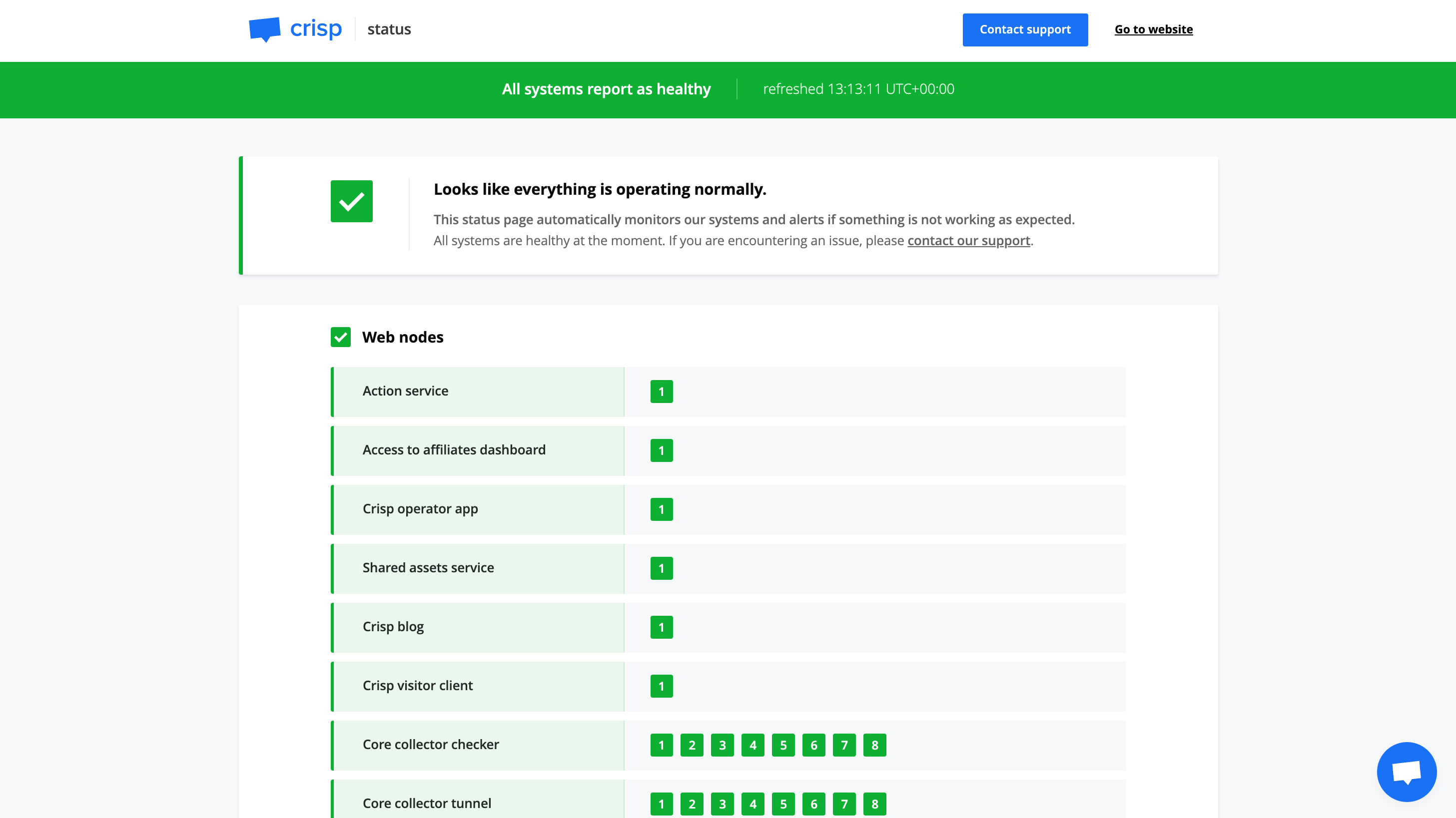
Vigil is an open-source status page tool that provides user-friendly features for creating and managing status pages. It offers customization options such as custom domain, company logo, and incident templates. Vigil also supports integration with external monitoring tools, making it a flexible option for users who prefer to use their own monitoring setup. Being open-source, Vigil provides the advantage of being highly customizable and extensible according to specific requirements.
Pros
- Open-source tool with customizable features.
- User-friendly interface for easy status page creation and management.
- Customization options for domain, logo, and incident templates.
- Supports integration with external monitoring tools.
- Highly customizable and extensible for specific requirements.
Cons
- May require technical expertise for setup and configuration.
- May not have as extensive features as some other commercial tools.
- Community support for open-source tools may vary.
Features of Status Page Tools
Status page tools come with a variety of features that can help organizations effectively manage their service disruptions and communicate with their users. Here are some common features of status page tools:
Incident Management
Incident management is a crucial feature of status page tools that allows organizations to create, manage, and communicate incidents or issues affecting their services. This feature typically includes incident creation, tracking, and resolution, as well as notifications to keep users updated in real-time.
Customization
Customization options are important for organizations to brand their status pages and provide a consistent user experience. Status page tools often offer customization options such as custom templates, custom branding, and custom CSS/HTML/JS, allowing organizations to create a status page that aligns with their brand identity.
Real-time Updates
Real-time updates are essential for keeping users informed about the status of a service or system in real-time. Status page tools typically provide real-time updates on incidents, outages, or maintenance events, allowing organizations to communicate the current status of their services to their users in real-time.
Integration with Notification Channels
Integration with notification channels is another key feature of status page tools. These tools often allow organizations to integrate their status pages with various notification channels, such as email, SMS, Slack, or other messaging platforms, to ensure that users receive timely updates about the status of their services.
Customizable Templates
Many status page tools offer customizable templates that allow organizations to create a visually appealing and informative status page without having to design from scratch. These templates typically come with pre-designed layouts, color schemes, and fonts, which can be customized to match the organization's branding and style.
Historical Incident Tracking
Historical incident tracking is a feature that allows organizations to keep a record of past incidents, including their causes, resolutions, and timelines. This feature helps organizations to track and analyze incidents over time, identify patterns, and improve their incident management processes.
Multi-language Support
Multi-language support is a crucial feature for organizations that serve a global user base. Status page tools that offer multi-language support allow organizations to create status pages in different languages, ensuring that their users can access status updates in their preferred language.
Access Controls
Access controls are important for organizations to manage who has permission to create, edit, and update incidents on their status pages. Status page tools often provide role-based access controls, allowing organizations to define user roles with specific permissions, ensuring that only authorized users can make changes to the status page.
Best Practices for Setting up and Managing a Status Page
Setting up and managing a status page requires careful planning and execution to ensure that it effectively communicates the status of a service or system to users. Here are some best practices for setting up and managing a status page:
Clearly Define Incident Severity Levels
Organizations should clearly define incident severity levels, such as high, medium, and low, and assign them based on the impact and urgency of the incident. This helps in prioritizing incidents and communicating their severity to users accurately.
Use Clear and Concise Language
Status page updates should use clear and concise language that is easy for users to understand. Avoid technical jargon and use plain language to communicate the status of a service or system and its impact on users.
Provide Timely and Regular Updates
Timely and regular updates are critical during incidents or outages to keep users informed about the status of the service or system. Provide updates at regular intervals, even if there is no significant change in the status, to reassure users that the incident is being actively monitored and worked on.
Be Transparent and Honest
Transparency and honesty are key principles in managing a status page. Organizations should provide accurate and honest updates about the status of the service or system, including the cause of the incident, the estimated time for resolution, and any workarounds or mitigation measures in place.
Test the Status Page
Before making the status page live, organizations should thoroughly test it to ensure that it is functioning correctly and providing accurate information. Test different scenarios, such as incidents, outages, and maintenance events, to ensure that the status page updates and notifications are working as expected.
Communicate Proactively
Proactive communication is crucial in managing a status page effectively. Organizations should communicate proactively with users through multiple channels, such as email, SMS, and social media, to ensure that users are aware of the status page and can access the latest updates.
Monitor and Analyze Incidents
Organizations should monitor and analyze incidents to identify patterns, trends, and areas of improvement. This can help in refining incident management processes, identifying root causes, and implementing preventive measures to minimize future incidents.
Real-World Examples of Status Page Usage
Here are some real-world examples of organizations effectively using status page tools to communicate with their users during incidents, outages, or maintenance events:
Slack
Slack, a leading communication and collaboration platform, uses a status page to communicate with their users during incidents or outages. Their status page provides real-time updates about the status of their services, including information about incidents, their causes, and estimated time for resolution. They also provide proactive notifications through multiple channels, such as email and social media, to keep their users informed.
Dropbox
Dropbox, a popular cloud storage and file sharing service, uses a status page to communicate with their users during incidents, outages, or maintenance events. Their status page provides updates about the status of their services, including information about incidents, their severity levels, and progress towards resolution. They also provide historical incident tracking, allowing users to view past incidents and their resolutions.
GitHub
GitHub, a web-based hosting service for version control and collaborative software development, uses a status page to communicate with their users during incidents or outages. Their status page provides real-time updates about the status of their services, including information about incidents, their impact, and estimated time for resolution. They also provide customization options, allowing users to customize the appearance of their status page to match their branding.
Conclusion
In today's digital world, service disruptions, incidents, and outages are inevitable. However, how organizations communicate and manage these incidents can significantly impact their users' experience and perception of their services. A well-designed and well-managed status page can be a powerful tool for organizations to effectively communicate the status of their services during incidents, outages, or maintenance events, and keep their users informed and updated.
By providing real-time updates, customization options, historical incident tracking, and access controls, status page tools can help organizations maintain transparency, manage user expectations, and minimize the impact of incidents on their users. Best practices such as defining incident severity levels, using clear and concise language, providing timely and regular updates, being transparent and honest, testing the status page, proactive communication, and monitoring and analyzing incidents can further enhance the effectiveness of a status page.
Real-world examples of organizations successfully using status page tools, such as Slack, Dropbox, GitHub, and Atlassian, showcase how status pages can be effectively utilized to communicate with users during incidents or outages, ensuring transparency, trust, and customer satisfaction.
In conclusion, organizations should consider implementing a robust and well-managed status page as part of their incident management strategy to effectively communicate with their users during incidents, outages, or maintenance events, and maintain transparency and trust in their services. With the right tools, best practices, and proactive communication, a status page can be a valuable resource in managing incidents and minimizing their impact on users, ultimately contributing to better user experience and customer satisfaction.

